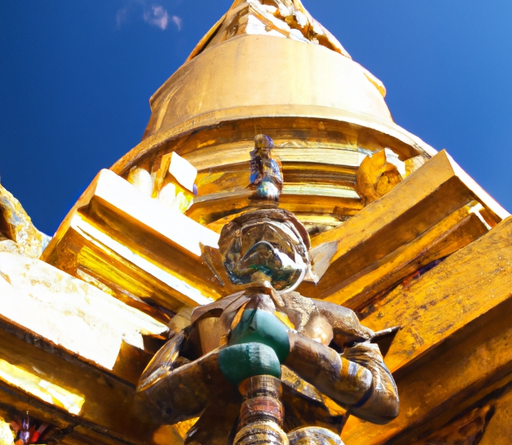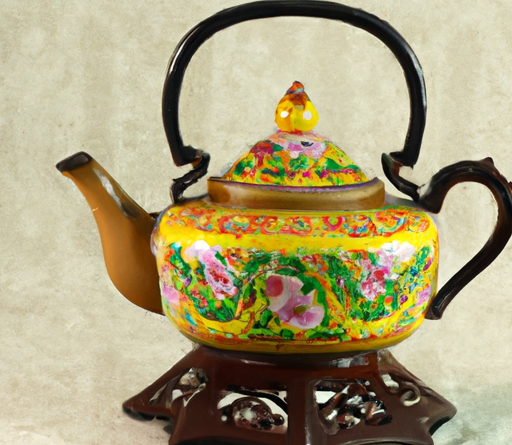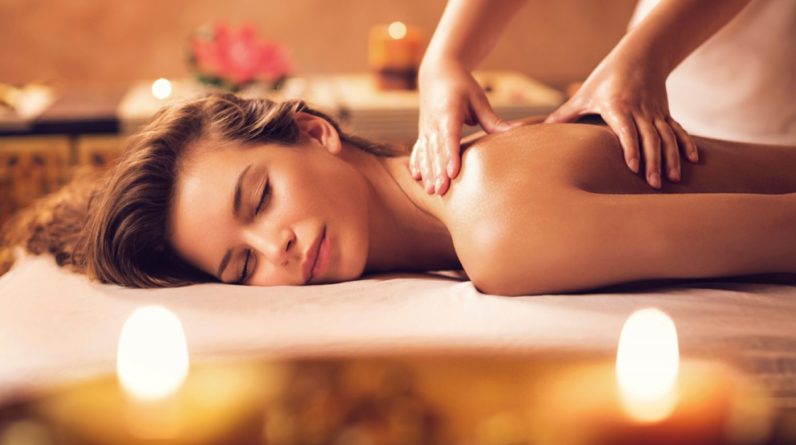
Welcome to the world of Thai massage and wellness! In this article, we’ll be exploring the incredible benefits of Thai massage and how it can bring rejuvenation and relaxation to your life.
Wondering what Thai massage is all about? Well, get ready to discover the ancient healing art that combines acupressure, yoga, and stretching techniques. Thai massage is not your typical massage experience. It involves a unique combination of gentle rocking, deep stretching, and rhythmic compression to relieve muscle tension, improve flexibility, and promote overall well-being. So if you’re in need of some relaxation and a little pampering, stay tuned to learn more about the wonders of Thai massage and how it can benefit you.
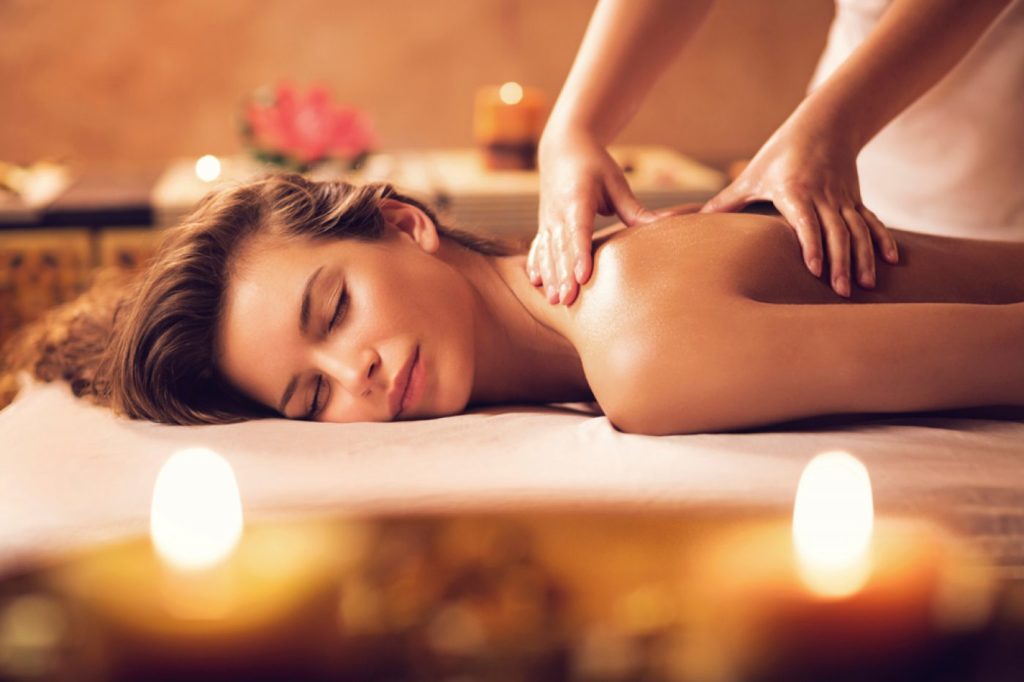
This image is property of globalspaonline.com.
What is Thai Massage?
Thai massage is a traditional healing system that originated in Thailand over 2,500 years ago. Also known as “nuad phaen boran” or “ancient massage,” Thai massage combines various techniques and principles to promote physical and mental well-being. It is deeply rooted in the belief that life energy, called “lom,” flows through the body along energy lines, known as “sen.” Thai massage aims to balance the body’s energy, release any blockages, and restore harmony to the mind, body, and spirit.
Origins and History of Thai Massage
The origins of Thai massage can be traced back to the time of Buddha. It is believed that Thai massage was developed by a physician named Jivaka Kumarabhacca, who was a contemporary and personal physician to the Buddha himself. Driven by a strong belief in the healing power of touch and a desire to alleviate suffering, Dr. Kumarabhacca combined his knowledge of Ayurveda (the ancient Indian healing system) with traditional Thai healing techniques to create Thai massage.
Over the centuries, Thai massage evolved and absorbed influences from neighboring countries, such as China and India. It subsequently became an integral part of Thai culture and was practiced not only as a therapeutic method but also as a means of promoting mindfulness, spirituality, and overall well-being.
Techniques and Principles of Thai Massage
Thai massage involves a combination of techniques that are designed to mobilize joints, stretch muscles, and apply pressure along energy lines. Unlike other types of massages, Thai massage is performed fully clothed on a mat on the floor, allowing the practitioner to use their whole body to apply various techniques.
The principles of Thai massage are centered around the concept of energy lines and sen. Practitioners apply rhythmic pressure and gentle stretches along these lines to release any blockages and restore the natural flow of energy within the body. They also utilize techniques such as deep stretching, compressions, acupressure, and joint mobilization to promote relaxation, flexibility, and overall well-being.
Health Benefits of Thai Massage
Thai massage offers numerous physical and mental health benefits. Here are some of the most notable ones:
Improves Blood Circulation
During a Thai massage, the practitioner applies pressure and manipulates the body, leading to improved blood circulation. This increase in blood flow helps deliver oxygen and nutrients to the tissues, promotes the removal of metabolic waste, and enhances overall health and vitality.
Relieves Muscle Tension and Pain
Thai massage is renowned for its ability to relieve muscle tension and pain. Through the use of stretching and pressure techniques, it helps relax tight muscles, reduce muscle spasms, and alleviate discomfort. It also improves flexibility and joint mobility, making it particularly beneficial for individuals with chronic muscle pain or injuries.
Boosts Immune System
Studies have shown that Thai massage can positively impact the immune system. The gentle stretches and rhythmic movements involved in Thai massage stimulate the lymphatic system, which plays a crucial role in removing toxins and waste from the body. This stimulation helps enhance the body’s natural defense mechanisms and promotes overall immune function.
Reduces Stress and Anxiety
One of the most significant benefits of Thai massage is its ability to induce deep relaxation and reduce stress and anxiety. The rhythmic, flowing movements, combined with the meditative atmosphere created during a Thai massage session, help calm the mind and promote a sense of tranquility. It also activates the body’s relaxation response, leading to decreased levels of stress hormones and an overall sense of well-being.
Enhances Flexibility and Range of Motion
Thai massage incorporates deep stretches and passive yoga-like movements, making it highly effective for increasing flexibility and improving range of motion. Regular Thai massage sessions can help lengthen and strengthen muscles, improve joint mobility, and enhance overall flexibility. This can be particularly beneficial for athletes looking to improve their performance or individuals experiencing limited mobility.
Different Styles of Thai Massage
Thai massage encompasses a range of different styles, each with its own unique techniques and focuses. Here are some of the most popular styles of Thai massage:
Traditional Thai Massage
Traditional Thai massage, also known as “nuad paan boran”, is the most common and widely practiced style of Thai massage. It involves a combination of acupressure, rhythmic stretching, and deep compression techniques to promote overall wellness and balance within the body.
Thai Oil Massage
Thai oil massage incorporates the use of essential oils, which are applied to the body during the massage. The oils help lubricate the skin, facilitating smoother movements and enhancing the overall relaxation and rejuvenation experience.
Thai Herbal Compress Massage
In Thai herbal compress massage, heated herbal compresses are used alongside traditional Thai massage techniques. These compresses are made of a blend of aromatic herbs and spices that are known for their therapeutic properties. The heat and aroma from the compresses help relax the muscles, reduce inflammation, and promote overall well-being.
Thai Foot Massage
Thai foot massage, or “nuad thao” in Thai, focuses specifically on the feet, lower legs, and lower body. It combines elements of reflexology with traditional Thai massage techniques to stimulate specific reflex points on the feet and promote the body’s natural healing process. Thai foot massage is known for its relaxing and energizing effects.
Thai Yoga Massage
Thai yoga massage, also known as “nuad bo rarn,” combines yoga-like stretches with massage techniques. The practitioner uses their hands, feet, knees, and elbows to apply pressure and facilitate deep stretches, creating a harmonious blend of massage therapy and yoga movements. Thai yoga massage helps improve flexibility, balance energy, and promotes a deep sense of relaxation.
Thai Massage Techniques
Thai massage incorporates various techniques that work together to promote physical and mental well-being. Here are some of the key techniques used in Thai massage:
Deep Stretching
Deep stretching is a fundamental technique in Thai massage. It involves gently stretching the muscles, tendons, and fascia to release tension, increase flexibility, and improve overall range of motion. The practitioner carefully guides and supports the client through a series of stretching movements, ensuring comfort and relaxation throughout the process.
Compressions and Acupressure
Thai massage involves the application of rhythmic compressions along energy lines and acupressure points in the body. Using their hands, thumbs, elbows, and sometimes even their feet, the practitioner applies gentle to firm pressure to specific points, helping to release tension, improve circulation, and restore the natural flow of energy.
Joint Mobilization
Thai massage includes techniques to mobilize and manipulate the joints effectively. By using gentle stretches, rotations, and manipulations, the practitioner helps improve joint flexibility and overall joint health. Joint mobilization techniques are particularly beneficial for individuals with limited joint mobility or those recovering from injuries or surgeries.
Energy Line Work
The concept of energy lines, or sen, is central to Thai massage. The practitioner focuses on applying techniques along specific energy lines to stimulate the flow of energy and promote balance within the body. By working along these lines, blockages can be cleared, allowing energy to flow freely and improving overall physical and mental well-being.
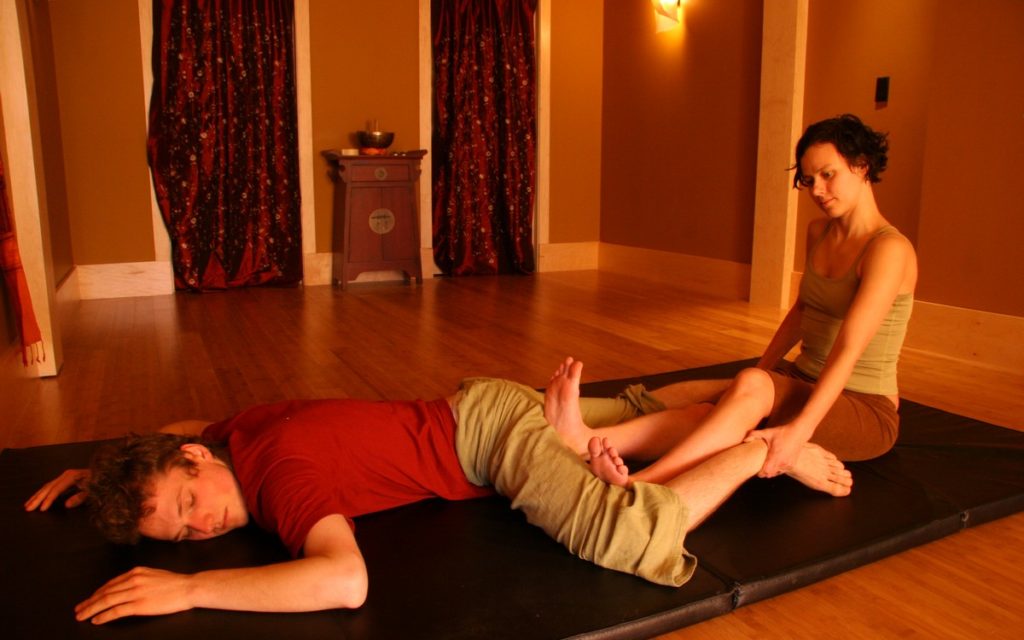
This image is property of globalspaonline.com.
Role of Meditation and Breathing in Thai Massage
In addition to the physical techniques, meditation and deep breathing play an essential role in Thai massage. These practices help create a mindful and meditative atmosphere that is conducive to relaxation and healing.
Mindful Presence and Meditation
Thai massage is traditionally performed with an emphasis on mindfulness and presence. Both the practitioner and the recipient are encouraged to be fully present in the moment, focusing their attention on the massage and their breath. This mindful presence enhances the therapeutic effects of the massage and promotes a deep state of relaxation.
Importance of Deep Breathing During the Massage
Deep breathing is an integral part of Thai massage. Practitioners often guide the recipient to take slow, deep breaths throughout the session. Deep breathing helps promote relaxation, reduce tension, and enhances the body’s ability to receive and release the physical and energetic benefits of the massage. By consciously focusing on their breath, individuals can deepen their relaxation experience and enhance the overall effects of the massage.
Preparing for a Thai Massage Session
Preparing for a Thai massage session involves a few essential steps to ensure your comfort and maximize the benefits of the massage.
Finding a Reputable Thai Massage Center
When seeking a Thai massage, it’s important to choose a reputable and experienced Thai massage center. Look for centers that employ certified and trained practitioners who have a deep understanding of Thai massage techniques and principles. Reading reviews, seeking recommendations, and checking for proper certifications can help identify a trustworthy massage center.
What to Expect During a Session
During a Thai massage session, you can expect to be fully clothed and lying on a comfortable mat on the floor. The practitioner will guide you through a series of stretches, movements, and compressions using their hands, feet, and elbows. Thai massage is traditionally performed without the use of oils or lotions, so it’s important to wear loose and comfortable clothing that allows for ease of movement.
Proper Attire for Thai Massage
For a Thai massage session, it is recommended to wear loose and comfortable clothing that allows for full range of motion. Avoid wearing restrictive clothing, such as jeans or tight-fitted clothing, as it may hinder the practitioner’s ability to perform the techniques effectively. Opt for lightweight, breathable fabrics that allow for easy movement and comfort throughout the session.
Tips for Maximizing the Benefits
To maximize the benefits of a Thai massage session, consider the following tips:
-
Communicate with your practitioner: Before the session, communicate any specific concerns, injuries, or areas of focus you may have. This will allow the practitioner to tailor the massage to your needs and ensure a safe and effective session.
-
Practice deep breathing: Throughout the massage, focus on deep, slow breathing. This will help you relax, enhance the effects of the massage, and promote a sense of calm and well-being.
-
Stay hydrated: Drink plenty of water before and after your Thai massage session. Hydration helps flush out toxins and supports the body’s natural healing process.
-
Allow yourself time to rest and relax after the massage: After the session, take some time to rest and allow your body to fully integrate the benefits of the massage. This will help prolong the feelings of relaxation and rejuvenation.

This image is property of israeltripplanner.com.
Who Can Benefit from Thai Massage?
Thai massage offers a wide range of benefits and is suitable for various individuals seeking physical and mental well-being. Here are some individuals who can benefit from Thai massage:
Individuals with Chronic Pain or Injuries
Thai massage is highly effective in alleviating chronic muscle pain, tension, and stiffness. It can help improve circulation, release muscle knots, and promote overall relaxation and pain relief. Individuals with conditions such as back pain, neck pain, arthritis, fibromyalgia, or sports injuries can find relief and healing through regular Thai massage sessions.
Athletes Looking to Enhance Performance
Thai massage can be a valuable addition to an athlete’s training and recovery routine. By improving flexibility, range of motion, and muscle recovery, it can enhance athletic performance, prevent injuries, and speed up the healing process. Thai massage also helps athletes relax and reduce stress, allowing them to perform at their optimal level.
Those Seeking Relaxation and Stress Relief
The calming and soothing nature of Thai massage makes it an excellent choice for those seeking relaxation and stress relief. The rhythmic movements, deep stretches, and meditative atmosphere created during a Thai massage session help release tension, promote deep relaxation, and restore balance to the mind and body. It provides a much-needed break from the demands of daily life, allowing individuals to rejuvenate and unwind.
Contraindications and Precautions
While Thai massage is generally safe and beneficial for most individuals, there are certain contraindications and precautions to be aware of. It is important to consult with a healthcare professional before receiving a Thai massage, especially if you have any of the following conditions:
Pregnancy
Pregnant women should exercise caution when receiving Thai massage. Some techniques and positions may not be suitable for pregnant individuals, and it is essential to receive guidance from a qualified practitioner who has experience working with pregnant clients.
Certain Medical Conditions
Individuals with certain medical conditions, such as high blood pressure, diabetes, heart disease, or cancer, should consult with their healthcare provider before receiving a Thai massage. In some cases, modifications may need to be made to ensure the safety and comfort of the individual.
Recent Surgeries or Injuries
Individuals who have had recent surgeries or injuries should consult with their healthcare provider before receiving a Thai massage. The practitioner may need to modify certain techniques or avoid specific areas to prevent further injury or discomfort.

This image is property of res.klook.com.
Combining Thai Massage with Other Wellness Practices
Thai massage can be combined with other wellness practices to enhance its benefits and promote overall well-being. Here are some common combinations:
Yoga and Thai Massage
Yoga and Thai massage are complementary practices that share a focus on relaxation, flexibility, and overall well-being. Combining Thai massage with yoga can enhance the benefits of both practices, deepen stretches, and further promote relaxation and stress relief.
Meditation and Thai Massage
Meditation and Thai massage go hand in hand, as both practices promote mindfulness, presence, and deep relaxation. Integrating meditation into a Thai massage session can further enhance its therapeutic effects and create a more profound sense of peace and well-being.
Thai Massage and Aromatherapy
Aromatherapy, the use of essential oils for therapeutic purposes, can be combined with Thai massage to enhance relaxation and promote healing. The calming aroma of oils such as lavender or chamomile can deepen the relaxation experience, promote stress relief, and enhance overall well-being.
Conclusion
Thai massage offers a holistic approach to wellness, promoting rejuvenation and relaxation for both the mind and body. With its rich history, diverse techniques, and ability to address various health concerns, Thai massage has become a popular choice for improving physical and mental well-being. Whether you need relief from muscle tension, want to enhance your flexibility, or simply want to unwind and release stress, Thai massage provides a transformative experience that promotes balance, harmony, and overall well-being.
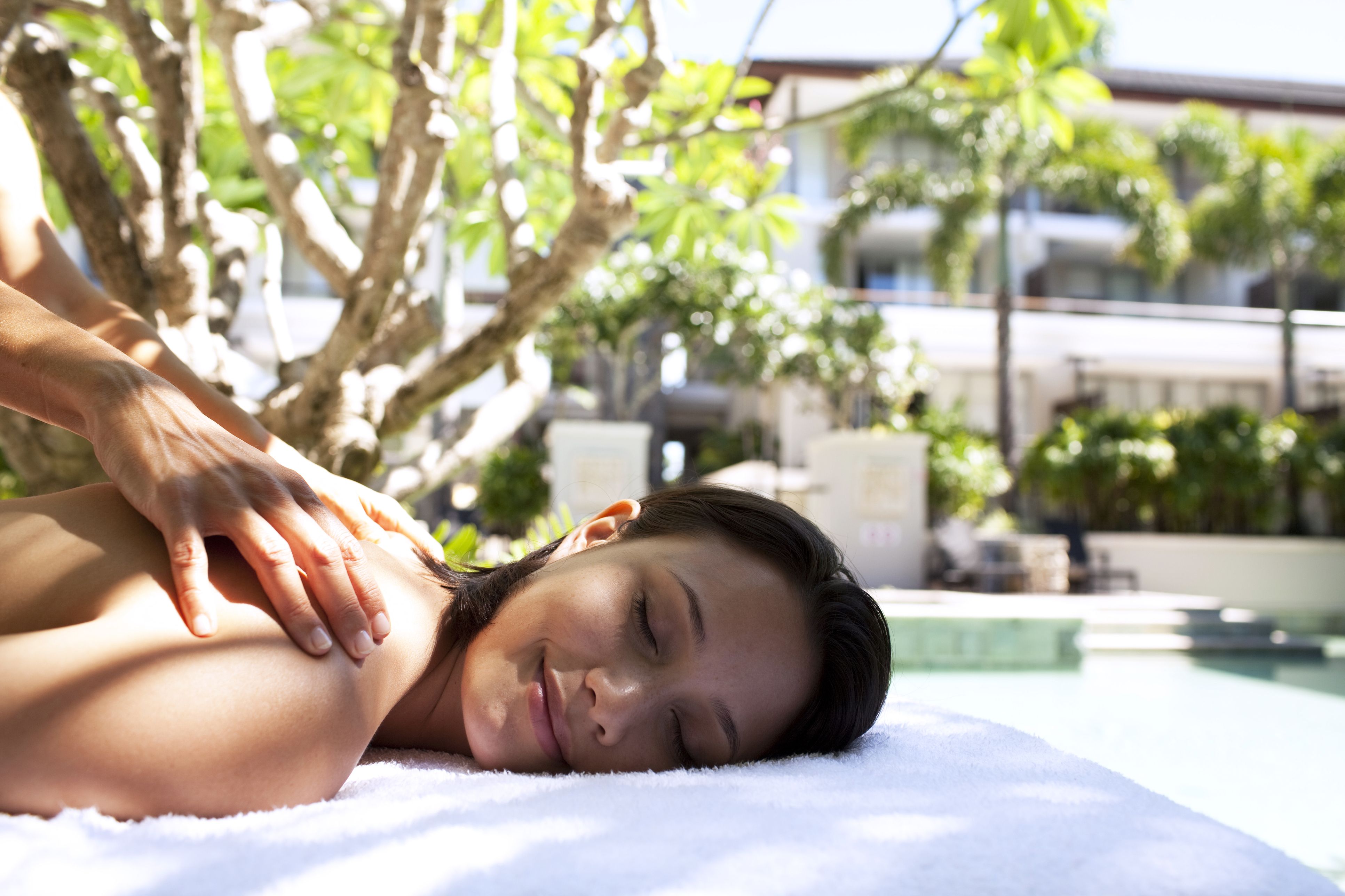
This image is property of hips.hearstapps.com.




